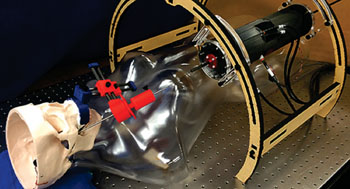Advanced Robotics Permit Brain Surgery Through the Cheek
By HospiMedica International staff writers
Posted on 28 Oct 2014
A prototype surgical robot can be precisely steered along a curving path, allowing brain surgery inside the powerful magnetic field created by a magnetic resonance imaging (MRI) scanner. Posted on 28 Oct 2014
Developed by researchers at Vanderbilt University (Nashville, TN, USA), the heart of the system is a shape-memory 1.14 mm nickel-titanium alloy ablation needle that is advanced inside a cannula—much like a mechanical pencil, with concentric, curved tube—thus allowing the tip to follow a curved path. To manipulate the active cannula and ablator, the robotic platform uses piston-cylinder pneumatic actuators that advance one millimeter at a time. The robotic platform controllably steers and advances the needle segments, using successive MRI scans to track needle position.

Image: A mockup of a patient in an MRI machine (Photo courtesy of David Comber, Vanderbilt University).
The hippocampus was selected for testing since surgery for epilepsy currently involves implanting electrodes into the brain to track activity and identify locations of hippocampal sclerosis. But since the hippocampus is in the lower section of the brain, straight needles cannot reach it, and surgeons must therefore drill through the coronal portion of the skull to insert ablation needles destroy the misbehaving neurons. The system was unveiled at the Fluid Power Innovation and Research Conference, held during October 2014 in Nashville (TN, USA).
“The systems we have now that let us introduce probes into the brain; they deal with straight lines and are only manually guided,” said associate Professor of Neurological Surgery Joseph Neimat, MD. “To have a system with a curved needle and unlimited access would make surgeries minimally invasive. We could do a dramatic surgery with nothing more than a needle stick to the cheek.”
Pneumatic actuators were selected instead of piezoelectric motors, as standard motor drives degrade MRI image quality unless powered down during imaging. The engineers also designed the system so that it can be fabricated using a three-dimensional (3-D) printer using additive manufacturing technology.
Related Links:
Vanderbilt University














